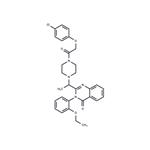Erastin, named for eradicator of RAS and small T (ST) antigen-expressing cells, is a ferroptosis inducer. It induces ferroptotic cell death in vitro, an effect that can be blocked by the ferroptosis inhibitors ciclopirox olamine, Trolox , ferrostatin-1 , U-0126 , cycloheximide , and β-mercaptoethanol. Erastin (5 μM) inhibits cystine uptake by the system xc- cystine-glutamate transporter in HT-1080 fibrosarcoma and Calu-1 lung carcinoma cells and inhibits glutamate release in an enzyme-coupled fluorescence assay (EC50 = 1.2 μM). It also selectively induces cell death in cells expressing the SV40 small T oncoprotein and oncogenic Ras (IC50s = 1.25-5 μg/ml).
Erastin, named for eradicator of RAS and ST-expressing cells, is an irreversible antitumor agent that selectively kills cells expressing the small T oncoprotein and oncogenic Ras (IC50s = 1.25-5 μg/ml). It produces non-apoptotic tumor cell death by altering mitochondrial voltage-dependent anion channel gating, allowing cations to enter mitochondria and leading to release of oxidative species causing oxidative cell death.[Cayman Chemical]
Erastin has been used:
- as a positive control for inducing ferroptosis in hepatic stellate cell (HSC)
- to induce ferroptosis and in transferrin internalization assay of human fibrosarcoma HT1080 cells
- to induce ferroptosis of muscle-derived cell lines
ChEBI: Erastin is a member of the class of quinazolines that is quinazolin-4(3H)-one in which the hydrogens at positions 2 and 3 are replaced by 1-{4-[(4-chlorophenoxy)acetyl]piperazin-1-yl}ethyl and 2-ethoxyphenyl groups, respectively. It is an inhibitor of voltage-dependent anion-selective channels (VDAC2 and VDAC3) and a potent ferroptosis inducer. It has a role as a ferroptosis inducer, an antineoplastic agent and a voltage-dependent anion channel inhibitor. It is a member of quinazolines, a member of monochlorobenzenes, an aromatic ether, a N-acylpiperazine, a N-alkylpiperazine, a diether and a tertiary carboxamide.
Erastin is a cell-permeable piperazinyl-quinazolinone. It interacts with antiporter system Xc-.
Erastin is an antitumor agent selective for tumor cells bearing oncogenic RAS (i.e. HRAS, KRAS). Erastin produces ferroptosis, a non-apoptotic tumor cell death, by altering mitochondrial voltage-dependent anion channel (VDAC) gating allowing cations to enter mitochondria and leading to release of oxidative species causing oxidative cell death.
1) Dolma et al. (2003), Identification of genotype-selective antitumor agents using synthetic lethal chemical screening in engineered human tumor cells; Cancer Cell, 3 285
2) Dixon et al. (2014), Pharmacological inhibition of cysteine-glutamate exchange induces endoplasmic reticulum stress and ferroptosis; Elife, 3 e02523
3) Sato et al. (2018), The ferroptosis inducer erastin irreversibly inhibits system xc-and synergizes with cisplatin to increase cisplatin’s cytotoxicity in cancer cells; Sci. Rep., 8 968
4) Yagoda et al. (2007), RAS-RAF-MEK-dependent oxidative cell death involving voltage-dependent anion channels; Nature, 447 864
![2-[1-[4-[2-(4-Chlorophenoxy)acetyl]-1-piperazinyl]ethyl]-3-(2-ethoxyphenyl)-4(3H)-Quinazolinone Structure](/CAS/GIF/571203-78-6.gif)

![2-[1-[4-[2-(4-Chlorophenoxy)acetyl]-1-piperazinyl]ethyl]-3-(2-ethoxyphenyl)-4(3H)-Quinazolinone pictures](https://img.chemicalbook.com/ProductImageEN/2019-12/Small/25d957d2-3e79-441f-be30-3dfc6a2249ec.jpg)